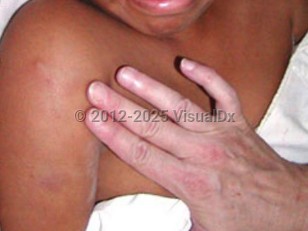Pyomyositis
Alerts and Notices
Important News & Links
Synopsis

The epidemiology of this infection is different in the tropics where it affects children and younger adults, often due to trauma, than in temperate regions where it is seen in adults often with intravenous drug use or with immunodeficiency such as human immunodeficiency virus (HIV) infection, hematologic malignancies, steroid use, chemotherapy use, and alcoholic liver disease.
While the most common pathogen causing this infection is S. aureus, other pathogens that have been implicated include group A Streptococcus and the enteric gram-negative organisms. Infections are typically due to a single organism, but can also be polymicrobial.
The course of infection is typically subacute. Initially, there is mild pain and local swelling. Fever and increasing pain at the site of involved muscle follows. It is at this point (10-21 days after the first symptoms of infection) that most patients present, and it is at this stage that pus can be aspirated from the infected muscle. Finally, signs of major systemic illness and sepsis manifest. Throughout the course of infection, erythema, fluctuance, and tenderness of the involved site evolve and become more prominent. Leukocytosis is common.
Imaging modalities (especially magnetic resonance imaging [MRI]) are important in the diagnosis of this infection and may help identify areas of infection that would benefit from surgical drainage.
Codes
M60.009 – Infective myositis, unspecified site
SNOMEDCT:
29689003 – Infective myositis
Look For
Subscription Required
Diagnostic Pearls
Subscription Required
Differential Diagnosis & Pitfalls

Subscription Required
Best Tests
Subscription Required
Management Pearls
Subscription Required
Therapy
Subscription Required
Drug Reaction Data
Subscription Required
References
Subscription Required

